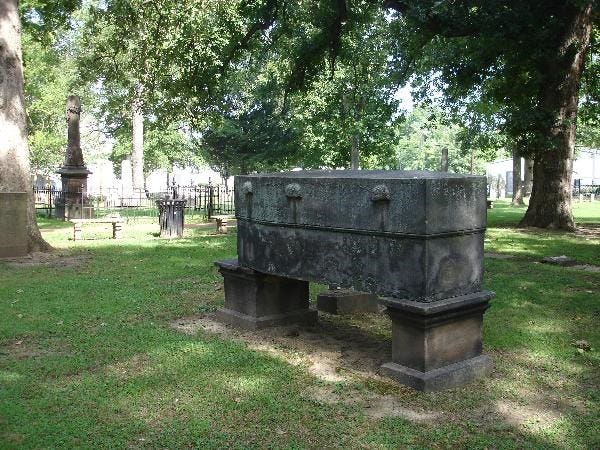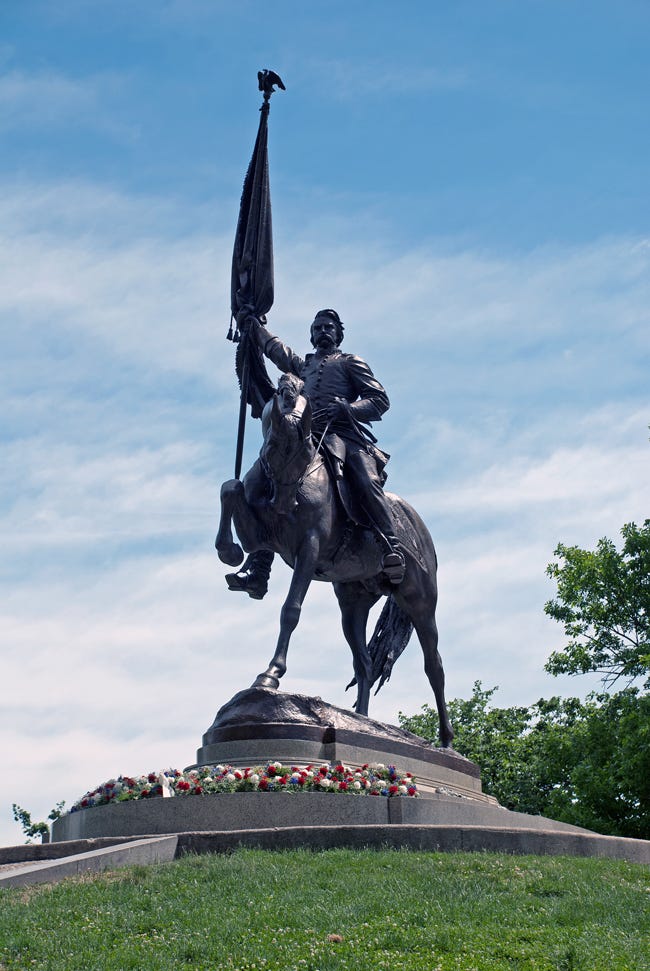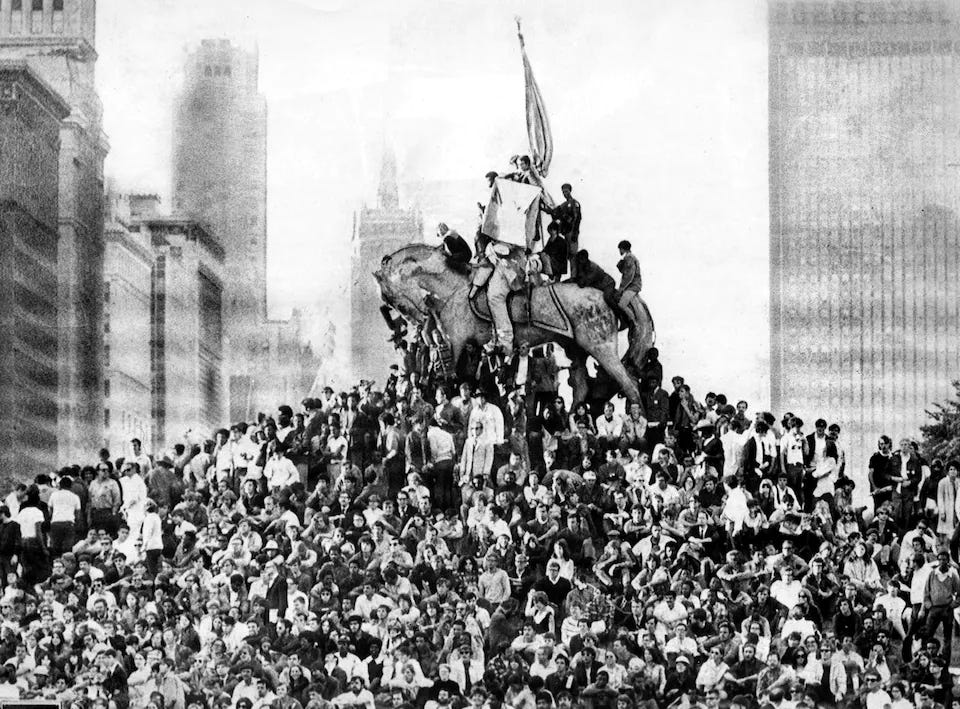Memorial Day is filled with meanings & memories.
Mine includes doing homework in the shadow of a mysterious graveyard resident
A million years ago, I did my undergraduate work at Southern Illinois University in Carbondale, IL, a small college town about 350 miles or so from my Chicago home. The town was anchored by “The Strip” a street packed with student-oriented bars. Another joint, PK’s, was a pizza place/saloon which really was a front for a scary biker club. Snotty college kids would go slumming at PK’s after class while motorcycle gang members would give them the evil eye. I can personally testify to that one. In retrospect, those bikers were right. We were tourists in their world, regarding them as little more than leather-and-denim clad anti-Disney characters rather than human beings. (PK’s has since become “respectable,” as it were, a sort of “dive bar” for people who want to be charmed by a “dive bar.”)
Carbondale was known nationwide not for its many fine educational programs, but rather its insane Halloween celebrations. People came from all over the country to join SIU students on the Saturday night closest to Halloween. Tens of thousands of people would create a unique madness. It was a sea of costumed people, undulating as one giant mass in a six-block range. It wasn’t something you went to, but something you experienced, preferably with a few beers in you.
I once went as the character of Death from Ingmar Bergman’s The Seventh Seal, wearing a sheet died black, carrying a stick that resembled a scythe, plus a pale skull rubber mask. Some drunk grabbed me from my at-the-time-sort-of-girlfriend (looking back, we really hated each, other than the sex and even then). He went for her, missed, and tried to kiss me instead. Once I saw some guys rolling an old Volkswagen end over end on the street, crowds be damned. It was that kind of scene.
The rest of the year Carbondale could still be noisy, given the bar scene and other college town shenanigans. Finding a quiet place to study was sometimes challenging. There was always the library, though often it was more of a place for me to take a nap rather than throw myself into books. Either that, or I’d be distracted by the magazines lining the racks, particularly The Village Voice. Ads in the back pages of The Voice for New York’s “adult entertainment” world in its most sleazy glory grabbed me by the eyeballs and didn’t let go until I finally hit Times Square a few years later in what was the twilight of 42nd Street’s rough decadent beauty.
So the library was out. I needed a place with less distraction. I found it a few blocks from my one-room apartment on 512 South Hays Street, at Woodlawn Cemetery, a name that inevitably graces many a boneyard. There was a small bench where I settled with my books, notepads, and sometimes my portable typewriter. I was usually the only one there.
Old cemeteries fascinate me. They are outdoor museums, repositories of the past that are a study in nature and stone. Some grave markers at Carbondale’s Woodlawn are barely legible because of age; others cannot be read at all. Their names and epitaphs have been smoothed away by the natural elements of 15+ decades. Many graves predate the Civil War.
Southern Illinois is an unusual place when it comes to the state’s Civil War history. Though Illinois, home of the Union’s president Abraham Lincoln, was a northern state, pockets within the region sided with the Confederacy. Carbondale itself is south of the Mason-Dixon line. One long-time resident of the area told me that in the nearby Shawnee National Forest there are hallows where Confederate soldiers holed up, carving their names on the sides of cave walls.
There’s an unusual grave at Woodlawn, something I’ve never seen in any other sprawling historic cemetery or small country graveyard. There is a cement sarcophagus, about the size of coffin, perched on two small pillars. There was no plaque nor gravestone marking the structure. It just stood alone. In between my readings and writings I would stare at the thing, wondering who was inside, what was that person's story, how did he or she end up sealed in an above-ground box in a small town cemetery. Curiosity got the better of me. Figuring that someone in the local government had to know something about this unusual memorial, I called the town hall.
The woman who answered the phone must have fielded that that question many times before. She answered me with a bemused laugh tinged with a slight southern accent. She explained that the sarcophagus contained the remains of a loyal daughter of the Confederacy who spent her final days in Carbondale. Though the war was long over, this woman said she’d be damned before being she’d be buried in Yankee soil. Her final wish was granted, hence the sarcophagus on two pedestals rather than Union dirt. Her widowed husband supposedly sprinkled dirt from her native Vicksburg inside the box before it was sealed.
It's as good a story as any. Another version I later heard flips that narrative. According to this story the family of a Union veteran learned that a former Confederate soldier was to be buried at Woodlawn. Rather than have their loved one rest in the same grounds with a traitor, they had the Union man’s remains disinterred and moved to a cemetery in nearby Marion. They left the burial vault at Woodlawn, hence the sarcophagus is just an empty concrete box that was left behind.
The mystery is a story without end. Years before I was even roaming the earth, let alone hanging out at Woodlawn, a reporter for a local Southern Illinois paper did some digging—so to speak. He found good cases for both stories.
There's another historic aspect to Woodlawn, one I didn't find out until many years later when I was writing my book The Hoofs and Guns of the Storm: Chicago’s Civil War Connections. It’s a guidebook driven by history, detailing Chicago’s vital importance to Abraham Lincoln and the country at large during the War Between the States, told through monuments and stories both Union and Confederate.
One of the city’s best known statues is that of General John A. Logan, located across the street from the Hilton Hotel on the east side of Michigan Avenue at 9th Street. The statue became a rallying point for a different kind of Civil War during the August 1968 Democratic Convention. During the violent clashes of cops attacking Vietnam War protestors, several people clambered onto the statue, draping it with a Vietcong banner. Police officers pulled one young man off the Logan statue, breaking his leg in the action as they beat him with their clubs.
John A. Logan was born in 1826, in Murphysboro, a neighboring town to Carbondale. He fought in the 1847 Mexican war, then returned home where he was elected to the Illinois House of Representatives and then the United States Congress. After the war broke out, Logan fought at the first Battle of Bull Run while still a congressman. He resigned his seat, rejoined the Army, and served under General Ulysses S. Grant during the Battle of Vicksburg. Logan also was part of General Sherman’s March to the Sea, a mighty Union force that burned and blazed its way through the South.
Yet, despite his noble service as a Union general, rumors percolated through military honchos that Logan was a closeted Confederate sympathizer. General Sherman even had Logan relieved of his command, regardless of Logan’s victories during the March to the Sea. After the war Logan was reelected to Congress. Despite the rumors and humiliations, Logan remained proud of his service to the Union cause. He founded the Grand Army of the Republic (GAR), the national association of Union veterans. On April 19, 1866, Logan held a ceremony at Woodlawn Cemetery with other GAR members as a memorial to the honored dead. Two years later Logan issued an order to his peers:
“The 30th day of May, 1868 is designated for the purpose of strewing with flowers or otherwise decorating the graves of comrades who died in defense of their country during the late rebellion, and whose bodies now lie in almost every city, village, and hamlet churchyard in the land.”
Logan led a service of 150 people at Woodlawn Cemetery that day, at what can properly be called the first Decoration Day service in American history. As time and wars passed, Decoration Day became Memorial Day. Woodlawn Cemetery is now on the National Register of Historic Places.
Over the years Memorial Day morphed into an unofficial demarcation line between spring and summer, a three-day weekend holiday for cookouts with family and friends, But Memorial Day is not the end of cold spring days, kissed off with hotdogs and beer. It’s about honoring those who took up the sword to fight for the idea of America. It’s about remembering those who gave their lives for this idea.
Looking back at my college days, I take some pride knowing that I did my homework in such a historic place, the birthplace of a sacred day. Still, if you listen to the winds, you may hear a Confederate ghost sneering from the interior of her stone sarcophagus, a resting place that will never be covered within the confines of that damn Yankee soil.
What are your Memorial Day remembrances or unusual college stories? Share them in the space below or on my Twitter @realarnieb. And check out my website for more on my writing: www.arniebernstein.com









